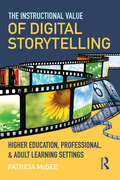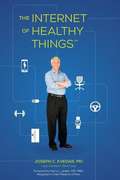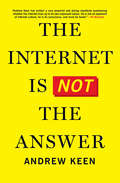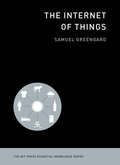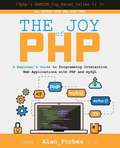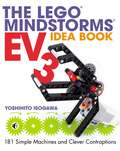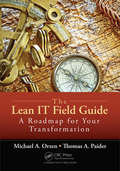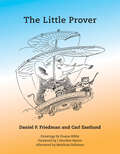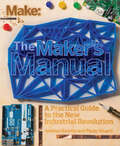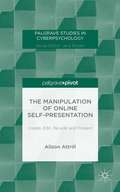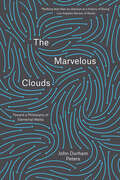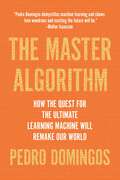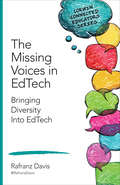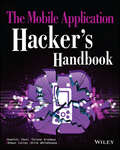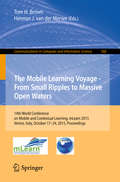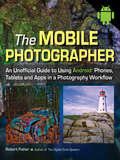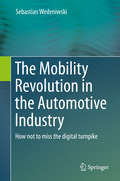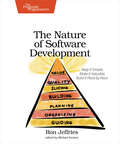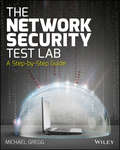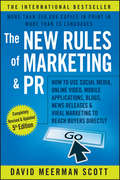- Table View
- List View
The Instructional Value of Digital Storytelling: Higher Education, Professional, and Adult Learning Settings
by Patricia McGeeAlthough storytelling has been recognized as an effective instructional strategy for some time, most educators are not informed about how to communicate a story that supports learning—particularly when using digital media. The Instructional Value of Digital Storytelling provides a broad overview of the concepts and traditions of storytelling and prepares professors, workplace trainers, and instructional designers to tell stories through 21st century media platforms, providing the skills critical to communication, lifelong learning, and professional success. Using clear and concise language, The Instructional Value of Digital Storytelling explains how and why storytelling can be used as a contemporary instructional method, particularly through social media, mobile technologies, and knowledge-based systems. Examples from different sectors and disciplines illustrate how and why effective digital stories are designed with learning theory in mind. Applications of storytelling in context are provided for diverse settings within higher education as well as both formal and informal adult learning contexts.
The Internet
by Meg GreveThis book details just what the Internet is, how it works, and how to be responsible when using it.
The Internet of Healthy Things
by Carol Colman Joseph C. Kvedar Gina CellaBy 2020, experts predict that more than 20 billion everyday objects will be able to capture, receive and share data via a vast, interconnected global network linked together by inexpensive sensors, GPS and 'the cloud. ' Just around the corner, real time biometric data will be automatically captured and used to learn more about the impact of lifestyle on chronic diseases and wellness, and ultimately change behavior to improve our health. A technological and social shift of this magnitude will be felt by virtually every sector of the economy, every business and every human being. It's a story that needs to be told by someone who has more than an academic understanding of this megatrend -- it needs to be told by someone who helped to create it. In his new book, The Internet of Healthy Things, (IoHT) connected health pioneer and visionary Dr. Joe Kvedar describes the phenomena driving this trend and the business opportunities that arise from it. Connecting to the IoHT presents a huge opportunity for all sectors of business and society, including payers, providers, pharma and biotech companies, and technology vendors , as well as newcomers to the space with fresh, creative ideas. This book shares Dr. Kvedar's observations as a 20-year veteran in the field.
The Internet Is Not the Answer
by Andrew KeenSince its creation during the Cold War, the Internet, together with the Web, personal computers, tablets and smartphones, has ushered in one of the greatest shifts in society since the Industrial Revolution. The Digital Revolution has contributed to the world in many positive ways, but we are less aware of the Internet’s deeply negative effects.The Internet Is Not the Answer, by longtime Internet skeptic Andrew Keen, offers a comprehensive look at what the Internet is doing to our lives. The book traces the technological and economic history of the Internet, from its founding in the 1960s through the rise of big data companies to the increasing attempts to monetize almost every human activity. In this sharp, witty narrative, informed by the work of other writers, reporters, and academics, as well as his own research and interviews, Keen shows us the tech world, warts and all.Startling and important, The Internet Is Not the Answer is a big-picture look at what the Internet is doing to our society and an investigation of what we can do to try to make sure the decisions we are making about the reconfiguring of our world do not lead to unpleasant, unforeseen aftershocks.
The Internet of Things (The MIT Press Essential Knowledge series)
by Samuel GreengardA guided tour through the Internet of Things, a networked world of connected devices, objects, and people that is changing the way we live and work.We turn on the lights in our house from a desk in an office miles away. Our refrigerator alerts us to buy milk on the way home. A package of cookies on the supermarket shelf suggests that we buy it, based on past purchases. The cookies themselves are on the shelf because of a “smart” supply chain. When we get home, the thermostat has already adjusted the temperature so that it's toasty or bracing, whichever we prefer. This is the Internet of Things—a networked world of connected devices, objects, and people. In this book, Samuel Greengard offers a guided tour through this emerging world and how it will change the way we live and work.Greengard explains that the Internet of Things (IoT) is still in its early stages. Smart phones, cloud computing, RFID (radio-frequency identification) technology, sensors, and miniaturization are converging to make possible a new generation of embedded and immersive technology. Greengard traces the origins of the IoT from the early days of personal computers and the Internet and examines how it creates the conceptual and practical framework for a connected world. He explores the industrial Internet and machine-to-machine communication, the basis for smart manufacturing and end-to-end supply chain visibility; the growing array of smart consumer devices and services—from Fitbit fitness wristbands to mobile apps for banking; the practical and technical challenges of building the IoT; and the risks of a connected world, including a widening digital divide and threats to privacy and security. Finally, he considers the long-term impact of the IoT on society, narrating an eye-opening “Day in the Life” of IoT connections circa 2025.
The Joy of PHP: A Beginner's Guide To Programming Interactive Web Applications With PHP And MySQL
by Alan ForbesThird Edition now with bonus chapters. Have you ever wanted to design your own website or browser application but thought it would be too difficult or just didn't know where to start? Have you found the amount of information on the Internet either too daunting or not geared for your skill set or worse-- just plain boring? Are you interested in learning to program PHP and have some fun along the way? If so, then The Joy of PHP by Alan Forbes is the book for you!! Alan starts with some basic HTML so the absolute beginner can catch up quickly and then goes step by step on how PHP works.
The Jungle Temple Oracle: The Mystery of Herobrine: Book Two: A Gameknight999 Adventure: An Unofficial Minecrafter's Adventure (The\mystery Of Herobrine Ser. #Bk. 2)
by Mark ChevertonAn ancient jungle temple holds the secrets to stopping the evil Herobrine! Gameknight999’s true enemy has finally surfaced: Herobrine, an artificially intelligent virus that wants to escape Minecraft and destroy mankind with their own creation--the Internet. If he is able to escape the game and get online, Herobrine will infect millions of computer systems and turn machines and weapons on their masters, threatening all of humanity. After facing Herobrine in battle and nearly dying, Gameknight realizes he’s going to need much more help to defeat this seemingly invincible enemy. His NPC friends tell him of the ancient Oracle residing in the oldest jungle temple in Minecraft who knows the secret to defeating this terrible threat. The path to the temple is fraught with danger, with zombies, spiders, and creepers lying in wait behind every tree and bush. Gameknight will enlist the help of his friends on his quest, but will they reach the Oracle in time to stop Herobrine? Gameknight999 will be tested to his limits, and perhaps beyond, in this spine-tingling new adventure.
The LEGO MINDSTORMS EV3 Idea Book: 181 Simple Machines and Clever Contraptions
by Yoshihito IsogawaThe LEGO® MINDSTORMS® EV3 Idea Book explores dozens of creative ways to build amazing mechanisms with the LEGO MINDSTORMS EV3 set. Each model includes a list of the required parts, minimal text, and colorful photographs from multiple angles so you can re-create it without the need for step-by-step instructions.You’ll learn to build cars with real suspension, steerable crawlers, ball-shooters, grasping robotic arms, and other creative marvels. Each model demonstrates simple mechanical principles that you can use as building blocks for your own creations.Best of all, every part you need to build these machines comes in one LEGO set (#31313)!
The Lean IT Field Guide: A Roadmap for Your Transformation
by Michael A. Orzen Thomas A. PaiderHow many IT books have you read that are long on theory and short on practical application? They are interesting, but not very impactful. They provide a framework from which to think and understand, but lack a process from which to act. Addressing this urgent need for the IT community, The Lean IT Field Guide explains how to initiate, execute, and sustain a lean IT transformation.Illuminating a clear path to lean IT, the authors integrate more than two decades of combined experience to provide you with a proven method for creating and sustaining a true lean IT workplace. This field guide not only highlights the organizational techniques of more agile and lean processes, but also the leadership work required to help management adopt these new approaches.Based on proven methods from different industries, including banking, manufacturing, insurance, food and beverage, and logistics, the book details a clear model that covers all the components you need to achieve and sustain a favorable work environment and culture in support of lean IT.Filled with anecdotes and case studies from actual businesses, the book includes pictures, templates, and examples that illustrate the application of the lean methods discussed.
The Little Prover
by Daniel P. Friedman Carl EastlundAn introduction to writing proofs about computer programs, written in an accessible question-and-answer style, complete with step-by-step examples and a simple proof assistant.The Little Prover introduces inductive proofs as a way to determine facts about computer programs. It is written in an approachable, engaging style of question-and-answer, with the characteristic humor of The Little Schemer (fourth edition, MIT Press). Sometimes the best way to learn something is to sit down and do it; the book takes readers through step-by-step examples showing how to write inductive proofs. The Little Prover assumes only knowledge of recursive programs and lists (as presented in the first three chapters of The Little Schemer) and uses only a few terms beyond what novice programmers already know. The book comes with a simple proof assistant to help readers work through the book and complete solutions to every example.
The Maker's Manual: A Practical Guide to the New Industrial Revolution
by Patrick Di Justo Paolo Aliverti Andrea MaiettaThe Maker's Manual is a practical and comprehensive guide to becoming a hero of the new industrial revolution. It features dozens of color images, techniques to transform your ideas into physical projects, and must-have skills like electronics prototyping, 3d printing, and programming. This book's clear, precise explanations will help you unleash your creativity, make successful projects, and work toward a sustainable maker business. Written by the founders of Frankenstein Garage, which has organized courses since 2011 to help makers to realize their creations, The Maker's Manual answers your questions about the Maker Movement that is revolutionizing the way we design and produce things.
The Manipulation of Online Self-Presentation: Create, Edit, Re-edit and Present
by Alison AttrillThis book explores psychological theories around the ways in which people present themselves online. The role of dispositional and situational factors along with the motivations that drive self-presentation across diverse Internet arenas are considered.
The Marvelous Clouds: Toward a Philosophy of Elemental Media
by John Durham PetersWhen we speak of clouds these days, it is as likely that we mean data clouds or network clouds as cumulus or stratus. In their sharing of the term, both kinds of clouds reveal an essential truth: that the natural world and the technological world are not so distinct. In The Marvelous Clouds, John Durham Peters argues that though we often think of media as environments, the reverse is just as true--environments are media. Peters defines media expansively as elements that compose the human world. Drawing from ideas implicit in media philosophy, Peters argues that media are more than carriers of messages: they are the very infrastructures combining nature and culture that allow human life to thrive. Through an encyclopedic array of examples from the oceans to the skies, The Marvelous Clouds reveals the long prehistory of so-called new media. Digital media, Peters argues, are an extension of early practices tied to the establishment of civilization such as mastering fire, building calendars, reading the stars, creating language, and establishing religions. New media do not take us into uncharted waters, but rather confront us with the deepest and oldest questions of society and ecology: how to manage the relations people have with themselves, others, and the natural world. A wide-ranging meditation on the many means we have employed to cope with the struggles of existence--from navigation to farming, meteorology to Google--The Marvelous Clouds shows how media lie at the very heart of our interactions with the world around us. Peters's book will not only change how we think about media but provide a new appreciation for the day-to-day foundations of life on earth that we so often take for granted.
The Master Algorithm: How the Quest for the Ultimate Learning Machine Will Remake Our World
by Pedro DomingosAlgorithms increasingly run our lives. They find books, movies, jobs, and dates for us, manage our investments, and discover new drugs. More and more, these algorithms work by learning from the trails of data we leave in our newly digital world. Like curious children, they observe us, imitate, and experiment. And in the world’s top research labs and universities, the race is on to invent the ultimate learning algorithm: one capable of discovering any knowledge from data, and doing anything we want, before we even ask. Machine learning is the automation of discovery--the scientific method on steroids--that enables intelligent robots and computers to program themselves. No field of science today is more important yet more shrouded in mystery. Pedro Domingos, one of the field’s leading lights, lifts the veil for the first time to give us a peek inside the learning machines that power Google, Amazon, and your smartphone. He charts a course through machine learning’s five major schools of thought, showing how they turn ideas from neuroscience, evolution, psychology, physics, and statistics into algorithms ready to serve you. Step by step, he assembles a blueprint for the future universal learner--the Master Algorithm--and discusses what it means for you, and for the future of business, science, and society. If data-ism is today’s rising philosophy, this book will be its bible. The quest for universal learning is one of the most significant, fascinating, and revolutionary intellectual developments of all time. A groundbreaking book, The Master Algorithm is the essential guide for anyone and everyone wanting to understand not just how the revolution will happen, but how to be at its forefront.
The Missing Voices in EdTech: Bringing Diversity Into EdTech (Corwin Connected Educators Series)
by Rafranz DavisMaking tech decisions from a diverse space starts here! This book offers leaders and teachers a reflective journey into diverse perspectives on technology as it is used and understood in our schools. Through step-by-step strategies and powerful vignettes, Rafranz Davis explores the deep impact inclusive EdTech conversations can have for teachers, students, women, and people of color. Educators learn practical, step-by-step solutions to: Engage students and give them a voice Cultivate diverse teacher feedback Encourage EdTech leadership for women and people of color Includes real-life stories from educators. Transform the EdTech landscape and create lasting change with this one-of-a-kind book! The Corwin Connected Educators series is your key to unlocking the greatest resource available to all educators: other educators. Being a Connected Educator is more than a set of actions: it’s a belief in the potential of technology to fuel lifelong learning. "Davis’s book is both a guide for administrators and edtech leaders seeking to better support student and teacher voices and an important testimony to the power of voices willing to raise the tough questions." —Carolyn Foote, Digital Librarian Westlake High School, Austin, Texas "Davis powerfully addresses the human side of technology integration. She moves teachers and school leadership with her passion, while offering real solutions to the issues that arise when integrating technology. Her solutions and ideas focus on improving the discourse between teachers, students, and leadership so that they all work collaboratively in enhancing the learning environment. She also addresses ways we can encourage women and minorities to take leadership roles in the field of education technology." —Shelly Sanchez Terrell Author/Founder of The 30 Goals Challenge for Teachers
The Missing Voices in EdTech: Bringing Diversity Into EdTech (Corwin Connected Educators Series)
by Rafranz DavisMaking tech decisions from a diverse space starts here! This book offers leaders and teachers a reflective journey into diverse perspectives on technology as it is used and understood in our schools. Through step-by-step strategies and powerful vignettes, Rafranz Davis explores the deep impact inclusive EdTech conversations can have for teachers, students, women, and people of color. Educators learn practical, step-by-step solutions to: Engage students and give them a voice Cultivate diverse teacher feedback Encourage EdTech leadership for women and people of color Includes real-life stories from educators. Transform the EdTech landscape and create lasting change with this one-of-a-kind book! The Corwin Connected Educators series is your key to unlocking the greatest resource available to all educators: other educators. Being a Connected Educator is more than a set of actions: it’s a belief in the potential of technology to fuel lifelong learning. "Davis’s book is both a guide for administrators and edtech leaders seeking to better support student and teacher voices and an important testimony to the power of voices willing to raise the tough questions." —Carolyn Foote, Digital Librarian Westlake High School, Austin, Texas "Davis powerfully addresses the human side of technology integration. She moves teachers and school leadership with her passion, while offering real solutions to the issues that arise when integrating technology. Her solutions and ideas focus on improving the discourse between teachers, students, and leadership so that they all work collaboratively in enhancing the learning environment. She also addresses ways we can encourage women and minorities to take leadership roles in the field of education technology." —Shelly Sanchez Terrell Author/Founder of The 30 Goals Challenge for Teachers
The Mobile Application Hacker's Handbook
by Ollie Whitehouse Dominic Chell Shaun Colley Tyrone Erasmus Jon LindsaySee your app through a hacker's eyes to find the real sources of vulnerability The Mobile Application Hacker's Handbook is a comprehensive guide to securing all mobile applications by approaching the issue from a hacker's point of view. Heavily practical, this book provides expert guidance toward discovering and exploiting flaws in mobile applications on the iOS, Android, Blackberry, and Windows Mobile platforms. You will learn a proven methodology for approaching mobile application assessments, and the techniques used to prevent, disrupt, and remediate the various types of attacks. Coverage includes data storage, cryptography, transport layers, data leakage, injection attacks, runtime manipulation, security controls, and cross-platform apps, with vulnerabilities highlighted and detailed information on the methods hackers use to get around standard security. Mobile applications are widely used in the consumer and enterprise markets to process and/or store sensitive data. There is currently little published on the topic of mobile security, but with over a million apps in the Apple App Store alone, the attack surface is significant. This book helps you secure mobile apps by demonstrating the ways in which hackers exploit weak points and flaws to gain access to data. Understand the ways data can be stored, and how cryptography is defeated Set up an environment for identifying insecurities and the data leakages that arise Develop extensions to bypass security controls and perform injection attacks Learn the different attacks that apply specifically to cross-platform apps IT security breaches have made big headlines, with millions of consumers vulnerable as major corporations come under attack. Learning the tricks of the hacker's trade allows security professionals to lock the app up tight. For better mobile security and less vulnerable data, The Mobile Application Hacker's Handbook is a practical, comprehensive guide.
The Mobile Learning Voyage - From Small Ripples to Massive Open Waters
by Tom H. Brown Herman J. MerweThis book constitutes the proceedings of the 14th InternationalConference on Mobile and Contextual Learning, mLearn 2015, held in a cruiseship leaving from and arriving to Venice, Italy, in October 2015. The 22 revised full papersand 6 short papers presented were carefully reviewed and selected from 81submissions. The papers deal with the topics related to the theme of theconference: "The mobile learning voyage: from small ripples to massiveopen waters". The conference theme paid tribute to the developmentsthat brought mobile learning from its infancy steps in the early 2000s tomaturity in 2015, while simultaneously paving the way for the broad andopen waters ahead with new developments and progress in mobile learning,and emerging ambient technologies.
The Mobile Photographer
by Robert FisherIt’s been said that, with smartphones, everyone is a photographer. There is a snide implication with that statement-that camera phones aren’t "real” cameras and that the people who use them aren’t "real” photographers. In this book, Robert Fisher proves that today’s Android devices offer cameras that are remarkably powerful and more than capable of producing images that rival those made with more "serious” equipment. In this book, Fisher guides readers through the menus of the Android operating system, helping them to understand how to choose and use out-of-the-box controls for better images. Next, he covers add-on accessories and applications designed to enhance the devices’ capabilities. While the photographic capabilities of the "base” camera are pretty terrific and will meet with rave reviews from many users, the camera really produces images that sing when suited up with DSLR functions, filters, and postproduction effects-all of which Fisher covers with prowess and technical skill.
The Mobile Photographer
by Robert FisherIt's been said that, with smartphones, everyone is a photographer. There is a snide implication with that statement-that camera phones aren't "real" cameras and that the people who use them aren't "real" photographers. In this book, Robert Fisher proves that today's Android devices offer cameras that are remarkably powerful and more than capable of producing images that rival those made with more "serious" equipment.In this book, Fisher guides readers through the menus of the Android operating system, helping them to understand how to choose and use out-of-the-box controls for better images. Next, he covers add-on accessories and applications designed to enhance the devices' capabilities. While the photographic capabilities of the "base" camera are pretty terrific and will meet with rave reviews from many users, the camera really produces images that sing when suited up with DSLR functions, filters, and postproduction effects-all of which Fisher covers with prowess and technical skill.
The Mobility Revolution in the Automotive Industry
by Sebastian WedeniwskiThe Internet of Things, cloud computing, connected vehicles, Big Data, analytics -- what does this have to do with the automotive industry? This book provides information about the future of mobility trends resulting from digitisation, connectedness, personalisation and data insights. The automotive industry is on the verge of undergoing a fundamental transformation. Large, traditional companies in particular will have to adapt, develop new business models and implement flexibility with the aid of appropriate enterprise architectures. Transforming critical business competencies is the key concept. The vehicle of the digital future is already here -- who will shape it?
The Mortality Doctrine Series: The Complete Trilogy (The Mortality Doctrine)
by James DashnerFrom James Dashner, #1 New York Times bestselling author of the Maze Runner series, comes the complete collection of all three books in the bestselling Mortality Doctrine series— The Eye of Minds, The Rule of Thoughts, and The Game of Lives. This edge-of-your-seat cyber-adventure trilogy is the perfect gift for fans of Marie Lu and Brandon Sanderson. The VirtNet offers total mind and body immersion, and the more hacking skills you have, the more fun it is. Why bother following the rules when it’s so easy to break them? But some rules were made for a reason. Some technology is too dangerous to fool with. And one gamer has been doing exactly that, with murderous results. The government knows that to catch a hacker, you need a hacker. And they’ve been watching Michael. If he accepts their challenge, Michael will need to go off the VirtNet grid, to the back alleys and corners of the system human eyes have never seen—and it’s possible that the line between game and reality will be blurred forever. Also look for James Dashner's Maze Runner series— The Maze Runner, The Scorch Trials, The Death Cure, The Kill Order, and The Fever Code. The first and second books, The Maze Runner and The Scorch Trials, are now major motion pictures featuring the star of MTV's Teen Wolf, Dylan O'Brien; Kaya Scodelario; Aml Ameen; Will Poulter; and Thomas Brodie-Sangster!
The Nature of Software Development: Keep It Simple, Make It Valuable, Build It Piece by Piece
by Ron JeffriesYou need to get value from your software project. You need it "free, now, and perfect." We can't get you there, but we can help you get to "cheaper, sooner, and better." This book leads you from the desire for value down to the specific activities that help good Agile projects deliver better software sooner, and at a lower cost. Using simple sketches and a few words, the author invites you to follow his path of learning and understanding from a half century of software development and from his engagement with Agile methods from their very beginning.The book describes software development, starting from our natural desire to get something of value. Each topic is described with a picture and a few paragraphs. You're invited to think about each topic; to take it in. You'll think about how each step into the process leads to the next. You'll begin to see why Agile methods ask for what they do, and you'll learn why a shallow implementation of Agile can lead to only limited improvement.This is not a detailed map, nor a step-by-step set of instructions for building the perfect project. There is no map or instructions that will do that for you.You need to build your own project, making it a bit more perfect every day. To do that effectively, you need to build up an understanding of the whole process.This book points out the milestones on your journey of understanding the nature of software development done well. It takes you to a location, describes it briefly, and leaves you to explore and fill in your own understanding.What You Need:You'll need your Standard Issue Brain, a bit of curiosity, and a desire to build your own understanding rather than have someone else's detailed ideas poured into your head.
The Network Security Test Lab
by Michael GreggThe ultimate hands-on guide to IT security and proactive defense The Network Security Test Lab is a hands-on, step-by-step guide to ultimate IT security implementation. Covering the full complement of malware, viruses, and other attack technologies, this essential guide walks you through the security assessment and penetration testing process, and provides the set-up guidance you need to build your own security-testing lab. You'll look inside the actual attacks to decode their methods, and learn how to run attacks in an isolated sandbox to better understand how attackers target systems, and how to build the defenses that stop them. You'll be introduced to tools like Wireshark, Networkminer, Nmap, Metasploit, and more as you discover techniques for defending against network attacks, social networking bugs, malware, and the most prevalent malicious traffic. You also get access to open source tools, demo software, and a bootable version of Linux to facilitate hands-on learning and help you implement your new skills. Security technology continues to evolve, and yet not a week goes by without news of a new security breach or a new exploit being released. The Network Security Test Lab is the ultimate guide when you are on the front lines of defense, providing the most up-to-date methods of thwarting would-be attackers. Get acquainted with your hardware, gear, and test platform Learn how attackers penetrate existing security systems Detect malicious activity and build effective defenses Investigate and analyze attacks to inform defense strategy The Network Security Test Lab is your complete, essential guide.
The New Rules of Marketing and PR
by David Meerman ScottThe most updated edition yet of the benchmark guide to marketing and PR, with the latest social media, marketing, and sales trends, tools, and real-world examples of success This is the fifth edition of the pioneering guide to the future of marketing. The New Rules of Marketing & PR is an international bestseller with more than 350,000 copies sold in over twenty-five languages. It offers a step-by-step action plan for harnessing the power of modern marketing and PR to directly communicate with buyers, raise visibility, and increase sales. This practical guide is written for marketing professionals, PR professionals, and entrepreneurs who want to grow their businesses and create success. Learn how companies, nonprofits, and organizations of all sizes can leverage web-based content to get timely, relevant information to eager, responsive buyers for a fraction of the cost of big-budget campaigns. This fifth edition--the most extensively revised edition yet--includes: Dozens of compelling case studies with revisions Real-world examples of content marketing and inbound marketing strategies and tactics A fresh introduction A new chapter on sales and service Coverage of the latest social media platforms, including Periscope, Meerkat, and Snapchat The New Rules of Marketing & PR is an unparalleled resource for entrepreneurs, business owners, nonprofit managers, and all of those working in marketing or publicity departments. This practical guide shows how to devise successful marketing and PR strategies to grow any business.David Meerman Scott is a marketing strategist, bestselling author of ten books--including three international bestsellers--advisor to emerging companies such as HubSpot, and a professional speaker on marketing, leadership, and social media. Prior to starting his own business, he was marketing VP for two publicly traded US companies and was Asia marketing director for Knight-Ridder, at the time one of the world's largest information companies.
